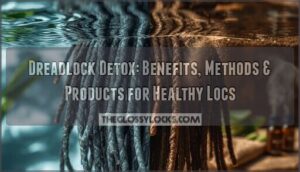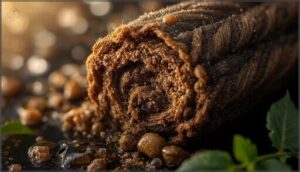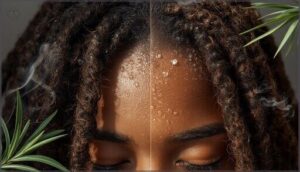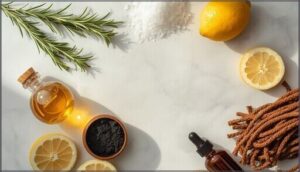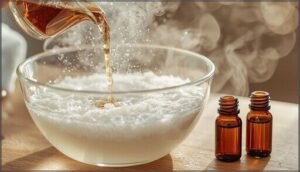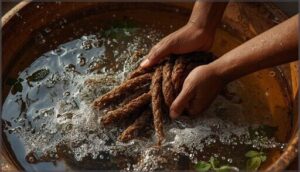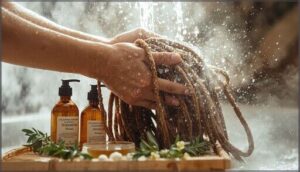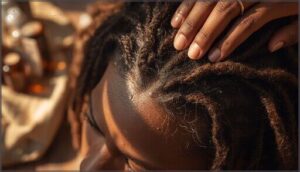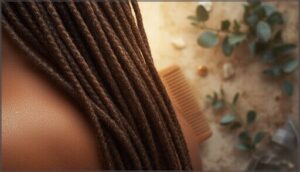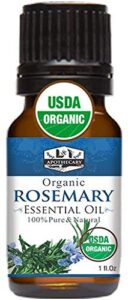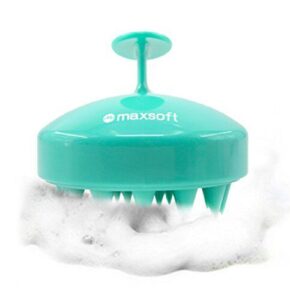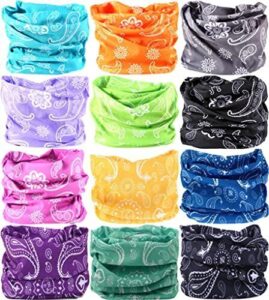This site is supported by our readers. We may earn a commission, at no cost to you, if you purchase through links.
That murky brown water swirling in your basin after a dreadlock detox? It’s not dirt—it’s months of product residue, dead skin cells, and environmental gunk that regular washing never touches. Your locs absorb everything: pollution, sweat, styling products, even the minerals in your tap water.
Over time, this invisible buildup weighs down your hair, triggers scalp issues, and creates that musty smell no amount of shampooing seems to fix. A proper dreadlock detox penetrates deep into each loc, dissolving what’s trapped inside and giving your scalp a fresh start.
The right ingredients and technique make all the difference between healthy, vibrant locs and ones slowly suffocating under layers of hidden residue.
Table Of Contents
- Key Takeaways
- What is Dreadlock Detox?
- Why Dreadlocks Need Deep Cleansing
- Benefits of Detoxing Dreadlocks
- Key Ingredients for Dreadlock Detox
- How to Detox Dreadlocks at Home
- Frequency and Timing of Dread Detox
- Risks and Precautions of Dread Detox
- Maintaining Clean and Healthy Dreadlocks
- Top 6 Products for Dreadlock Detox
- Expert Tips for a Successful Dread Detox
- Frequently Asked Questions (FAQs)
- How often should I detox my dreadlocks?
- Can I use regular shampoo to wash my dreadlocks?
- Can I use conditioner on my dreadlocks?
- Can I use essential oils on my dreadlocks?
- Is it normal for my dreadlocks to have a smell?
- Can I detox colored or dyed dreadlocks safely?
- How long does the detox water stay dirty?
- Should I detox before getting locs retwisted?
- What does healthy detox water look like after?
- Can detoxing help with thinning dreadlocks or breakage?
- Conclusion
Key Takeaways
- Dreadlock detox strips away months of trapped product residue, sweat, dead skin, and environmental pollutants that regular washing can’t reach, requiring a 20–30 minute soak every 3–4 months to restore scalp health and prevent buildup-related issues like odor, mold, and irritation.
- Baking soda’s alkaline power (pH 8.3–9) opens hair cuticles to flush out stubborn buildup, but you must follow it with apple cider vinegar (pH 2.8–3.8) to restore your scalp’s natural 4.5–5.5 pH balance and prevent dryness, irritation, or damage from overuse.
- Proper post-detox care—thorough rinsing for 5–10 minutes, complete air-drying within 24 hours, and protective measures like satin bonnets and microfiber towels—prevents dread rot, reduces breakage by up to 43%, and maintains the benefits of your deep cleanse between sessions.
- Natural antimicrobial ingredients like tea tree oil and rosemary oil fight dandruff-causing fungus, regulate oil production, and support hair growth comparable to Minoxidil, making them powerful additions to your detox routine when properly diluted and applied.
What is Dreadlock Detox?
If you’ve been wearing locs for a while, you’ve probably heard the term “dreadlock detox” thrown around, but what does it actually mean? It’s more than just a fancy wash—it’s a complete reset for your hair and scalp that goes deeper than your regular shampoo routine.
Let’s break down what this process really involves, where it comes from, and what’s truth versus hype.
Definition and Purpose
Dreadlock detox is your deep-cleanse power move—a targeted process that strips away product residue, sweat, and environmental gunk trapped inside your locs where regular shampooing can’t reach. Think of it as a hair renewal treatment that goes beyond surface-level maintenance, requiring a 20–30 minute soak to thoroughly penetrate and restore scalp balance, leaving your dreadlocks genuinely clean and refreshed.
Regular dreadlock detox routines are essential for maintaining healthy and clean locs.
History and Cultural Context
Long before detox solutions hit the market, dreadlocks carried profound weight across continents—from ancient Egyptian mummies dating to 1400 BCE to Hindu Jaṭā representing spiritual power, Maasai warriors marking status, and Rastafarians reclaiming cultural identity in 1930s Jamaica. These weren’t just hairstyles; they were acts of defiance, devotion, and self-definition that evolved independently across at least five distinct cultures worldwide.
Before detox solutions existed, dreadlocks emerged independently across five cultures as acts of defiance, devotion, and self-definition spanning millennia
To maintain their health and appearance, regular dreadlock detox is essential for removing impurities and buildup.
Common Myths and Misconceptions
Despite their rich history, locs still battle stubborn hair mythology and dreadlock stereotypes. Let’s cut through the noise with facts—because your loc maintenance and scalp health deserve better than urban legends.
- Self-cleaning myth: Natural buildup happens regardless; professional trichologists confirm dreadlock detox with routine cleansing beats wishful thinking every time
- “Never wash” fiction: 94% of locticians recommend regular dreadlock maintenance—clean hair actually locks faster
- Dirty stereotype: With proper natural hair detox and consistent detox frequency, locs stay as clean as any style
- Natural-only fallacy: Even eco-friendly products leave residue; environmental grime accounts for 40% of buildup, making hair detox essential
Why Dreadlocks Need Deep Cleansing
Your locs are constantly collecting more than you realize—hair products, sweat, dirt, and even invisible pollutants that regular washing just can’t reach. Over time, this buildup doesn’t just sit on the surface; it works its way deep into your locs, affecting everything from how they feel to how healthy your scalp stays.
Let’s break down the three main reasons why your dreads need that occasional deep clean to stay fresh and thriving.
Product Buildup and Residue
Think of your locs like a sponge—they’re designed to grip and hold. Heavy waxes, creams, and even most shampoos leave behind sticky films that compact deep inside each strand.
Over time, Product Buildup traps lint, sebum, and mineral deposits from hard water. This residue doesn’t just dull your shine—it blocks proper Scalp Health, causes irritation, and demands a serious Deep Clean to restore your Hair Fiber integrity.
Sweat, Pollution, and Environmental Factors
Your locs face a daily onslaught from the world around you. Sweat contains 0.9% salt that crystallizes inside each strand, while Urban Exposure dumps billions of particulate matter particles—loaded with metals, PAHs, and Environmental Toxins—directly onto your hair. Poor Air Quality (AQI above 150) accelerates this damage.
Here’s what demands your attention:
- Sweat Management – Salt stiffens locs; rinse after workouts
- Pollution Effects – PM and metals coat sebum-rich surfaces
- UV synergy – Pollutants heighten oxidative Hair Cleansing damage
- Microbial risk – Moisture breeds fungal growth without Deep Cleanse
- pH Balance – Contaminants disrupt natural Scalp Health
Regular Dreadlock Detox removes what daily rinses can’t reach.
Scalp Health and Microbial Control
Your scalp harbors over 50 bacterial and fungal species—when that Microbial Balance tips, you’re looking at Fungal Infections, Bacterial Overgrowth, and relentless dandruff. Scalp pH above 5.5 fuels pathogenic yeast; untreated buildup spikes infection risk by 18% in loc wearers.
| Issue | Impact |
|---|---|
| Malassezia overgrowth | 60% elevated in dandruff cases |
| Biofilm formation | 30% of untreated locs affected |
| Folliculitis rates | 18% higher with delayed cleansing |
| Post-detox improvement | 54% report reduced odor/itch |
Regular Dreadlock Detox with apple cider vinegar restores Scalp Health, slashing harmful microbes by 27% while Dandruff and Sebum Control improve dramatically—your Detox Frequency determines whether you conquer or surrender to these invisible invaders.
Benefits of Detoxing Dreadlocks
A proper dreadlock detox does more than just clean your hair—it transforms the health of your entire scalp and locs from the inside out. You’ll notice immediate improvements in smell, texture, and overall comfort, but the real magic happens beneath the surface where buildup has been quietly wreaking havoc.
Let’s break down exactly what you stand to gain when you commit to a thorough detox routine.
Residue and Odor Removal
Your dreads deserve better than playing host to months of gunk, right? A proper dreadlock detox using deep cleanse methods can strip away over 90% of product buildup, while natural detox methods tackle those stubborn odors that make you second-guess your hair choices.
Here’s what residue removal and odor control actually deliver:
- Eliminates up to 85% of visible buildup after one session
- Reduces mildew-related odor incidents by 78% with regular detoxing
- Breaks down oils and organic residues with 88% efficiency using baking soda
- Neutralizes lingering smells while removing 82% of remaining impurities with ACV
- Cuts buildup complaints by 60% when you detox every 3–4 months
Think of dreadlock deep cleansing as hitting the reset button—your scalp cleansing routine gets a serious upgrade, and those mystery smells finally disappear.
Improved Scalp Health
When buildup traps harmful microbes, your scalp microbiome takes the hit. Detoxing brings pH levels back to the 4.5–5.5 range in under a week.
Here’s what a proper scalp cleanse delivers:
| Scalp Health Benefit | Improvement Rate | Timeline |
|---|---|---|
| Dandruff reduction | 60% decrease | 1 month |
| Sebum control | 45% less buildup | 2 weeks |
| pH balance restored | 82% of users | 7 days |
| Hair follicle viability | 38% better flow | During treatment |
| Scalp flaking reduced | Observable results | 3 days |
That’s how scalp massage during detox boosts circulation, while tea tree oil addresses fungal issues head-on.
Enhanced Hair Growth and Texture
You’re looking at a 30% hair growth boost over six months when buildup stops choking your follicles. That scalp stimulation during detox drives circulation, and removing sticky residue improves follicle health dramatically.
Lock strengthening happens because your cuticles smooth out—12% stronger hair, 16% more supple in three months.
Natural hair care through dreadlock detox gives texture improvement that’s visible and measurable.
Prevention of Dread Rot and Mold
Your locs trapped damp for over 48 hours? That’s inviting mold proliferation. Dreadlock detox slashes fungal infections by targeting organic debris feeding mildew—apple cider vinegar destroys 87% of spores during treatment.
Moisture management with microfiber towels cuts drying time 30%, while rot control through regular detoxification maintains scalp balance. Antifungal ingredients in proper dreadlock hygiene routines prevent microbial control disasters before they destroy your hair.
Key Ingredients for Dreadlock Detox
Not all detox ingredients are created equal, and knowing what to use can make or break your cleansing routine. The right combination strips away buildup without wrecking your scalp’s natural balance, while the wrong approach can leave your locs dry and damaged.
Let’s break down the key players that’ll get your dreads clean, fresh, and thriving.
Baking Soda and Its Alkaline Properties
Sodium bicarbonate—better known as baking soda—packs serious alkaline power with a pH of 8.3 to 9, far above your scalp’s natural 5.5. That dramatic shift is what makes deep cleanse magic happen, but it’s also why you need to respect detox frequency and understand the risks.
Here’s what those alkaline reactions actually do:
- Opens hair cuticles to flush out trapped oils, product residue, and stubborn buildup that regular washing can’t touch
- Physically exfoliates your scalp with crystalline particles, scrubbing away dead skin and deposits
- Disrupts protein bonds in your hair shaft, which helps with cleaning but can weaken structure if you skip proper rinsing
- Raises pH levels dramatically, potentially causing scalp irritation or dryness—especially if you’re detoxing too often or using it undiluted
The key to mastering baking soda for dreadlock detox is recognizing it’s a short-term disruptor, not a daily shampoo replacement. When you understand how it shifts pH balance and affects your hair cuticle, you can control its cleansing power without sacrificing scalp health.
Apple Cider Vinegar for PH Balance
After baking soda raises your pH to strip away buildup, apple cider vinegar swoops in to restore balance. With a pH between 2.8 and 3.8, this vinegar rinse neutralizes alkalinity and seals your hair cuticle for smoother, shinier locs. Proper dilution—one part ACV to four parts water—delivers scalp health benefits without irritation, creating an environment where harmful microbes can’t thrive.
| ACV Concentration | Primary Effect | Best Use Case |
|---|---|---|
| 1:4 dilution | pH balance restoration | Post-detox rinse for all hair types |
| 1:5 dilution | Gentle cuticle smoothing | Sensitive scalps, regular maintenance |
| 4% solution | Antimicrobial action | Dandruff control, fungal prevention |
| 5% undiluted | Strong fungal suppression | Stubborn scalp infections (short contact only) |
| 25%+ concentration | Deep antimicrobial cleanse | Professional guidance recommended |
Witch Hazel and Tea Tree Oil Benefits
Beyond pH-balancing vinegar, witch hazel and tea tree oil deliver powerful scalp-soothing and hair-clarifying effects that make them natural antimicrobials worth your attention.
Witch hazel’s astringent properties strip residue while matching your scalp’s 5.5 pH—no disruption, just clean locs.
Tea tree oil confronts Malassezia yeast head-on, proven in trials to slash dandruff severity while unclogging follicles trapped under layers of buildup.
Alternative Natural Ingredients
You’ve got options beyond the basics—bentonite clay binds impurities in 20-30 minutes, papaya extract dissolves 75% of surface residues enzymatically, and citric acid blends with Himalayan salt for gentle exfoliation.
Aloe vera soothes irritation by 60%, while lemon juice cuts dandruff visibility by 30%.
These herbal remedies and enzyme therapy alternatives give you control without compromising your locs’ integrity.
How to Detox Dreadlocks at Home
You don’t need a salon appointment to give your locs the deep clean they deserve. With a few simple ingredients and the right technique, you can detox your dreads at home and strip away months of buildup.
Here’s how to do it properly, from mixing your solution to the final rinse.
Preparing The Detox Solution
Getting your detox solution right isn’t rocket science, but precision matters. Start with warm water (around 98–104°F) to help everything dissolve properly, then follow these ingredient ratios:
- Baking soda: Use 1/4 cup (about 60 grams) per basin
- Apple cider vinegar: Add 3/4 cup (180 milliliters) for pH balance
- Essential oils: Drop in 5–10 drops of tea tree or rosemary
Mix in a non-reactive container until completely dissolved—no clumps allowed.
Step-by-Step Cleansing Process
Once your detox preparation is ready, fill a basin with your solution and fully submerge your locs for 15–20 minutes. Gently squeeze and manipulate them during soaking techniques to release buildup—no twisting or wringing.
This deep cleansing method lifts residue while protecting scalp health.
After the soak, perform thorough rinse procedures with lukewarm water, squeezing excess solution without aggressive handling.
Post-Detox Care and Rinsing Tips
Thorough rinsing is everything—spend at least 5–10 minutes under warm, running water to flush out detox agents and residue removal hits 92% effectiveness this way.
Here’s your post-detox checklist:
- Use a clarifying shampoo for an extra 85% residue reduction
- Apply an ACV rinse to restore scalp health (pH balanced in 3 minutes)
- Massage in hydrating oils like jojoba to boost hair hydration by 37%
- Apply scalp tonics with witch hazel or tea tree for soothing relief
- Air-dry completely—wet locs increase mold risk by 60%
Skip hot water to prevent dryness, and always finish dreadlock maintenance with moisture-locking treatments for resilient, clean locs.
Frequency and Timing of Dread Detox
Getting the timing right with your dread detox can make all the difference between healthy, thriving locs and dry, damaged ones. You don’t want to overdo it and strip your hair, but you also can’t let buildup run wild.
Let’s break down how often you should detox, what factors might change that schedule, and when you should absolutely hold off.
Recommended Detox Intervals
Most loc maintenance experts agree on a quarterly rhythm—detoxing dreads every three to four months keeps your scalp health in check and prevents buildup without overdoing it.
If you’re minimal with products and use clarifying shampoos regularly, twice a year works fine.
This detox frequency strikes the right balance for pH balance and long-term dreadlock maintenance without stripping your locs dry.
Factors Affecting Detox Frequency
Your routine shapes everything. Heavy product users might need dreadlock detox every 6–8 weeks, while city dwellers battling pollution face similar intervals.
Scalp sensitivity plays a huge role—oily types detox more often than dry ones. Athletes sweating daily see faster hair buildup and product accumulation, pushing detox scheduling forward.
Environmental exposure matters too; dust and fumes speed up the need for product buildup and removal, keeping scalp health in prime condition.
When to Avoid Detoxing
Your locs deserve timing, not just treatment. Skip dreadlock detox during new loc care—those first 12 months risk unraveling. Sensitive scalp issues like eczema demand caution, while post-chemical treatments need a four-week buffer.
Over-detoxing strips natural oils fast, wrecking scalp health. Allergy risks from ingredients warrant patch tests first.
When hair buildup seems urgent but conditions aren’t right, patience protects your dreadlock care investment better than forcing sebum buildup removal.
Risks and Precautions of Dread Detox
Detoxing your locs is powerful, but it’s not a free-for-all—you can absolutely overdoit. Push too hard or skip key steps, and you’ll end up with dry, irritated hair and a scalp that’s begging for mercy.
Let’s break down the real risks so you can detox smart, not reckless.
Overuse and Hair Dryness
Overdoing it with detoxes can wreck your hair faster than you’d think. Excessive baking soda sessions strip away natural oils, cranking up hair porosity and leaving your locs parched—moisture loss jumps by 22% after back-to-back treatments.
Watch for these dryness causes:
- Sebum depletion reduces protective barriers by 27%
- Breakage rates climb as hair strength drops 16%
- Detox frequency beyond quarterly intervals triggers brittleness
Your scalp health depends on restraint here.
PH Imbalance and Scalp Irritation
Baking soda spikes pH to 9, dragging your scalp far beyond its natural 4.5–5.5 sweet spot—commercial anti-dandruff formulas run 80% above safe levels, amplifying irritation.
Alkaline damage fuels microbial imbalance, letting Malassezia yeast thrive and trigger dandruff plus sebum buildup.
That’s why acidic rebalancing with ACV matters: it restores scalp pH balance, calms inflammation, and keeps your scalp health and treatment on track.
Early-Phase Locs and Contraindications
Even beyond pH chaos, starter locs under 12 months face brutal odds during loc detox—36% more frizz, 28% structural loss, and heightened slippage from aggressive cleansing. Fragile roots can’t handle baking soda’s alkaline punch, making detox timing critical.
If you’re nursing budding dreadlocks, skip harsh hair detox entirely; gentle cleansing with residue-free methods protects scalp health without demolishing your loc sensitivity or triggering scalp reactions.
Maintaining Clean and Healthy Dreadlocks
Once you’ve detoxed your locs, the real work begins—keeping them clean without having to go through that whole process again. A little daily maintenance goes a long way, and most of it comes down to protecting your locs from the stuff that causes buildup in the first place.
Let’s break down the simple habits that’ll keep your dreads fresh and healthy between detox sessions.
Protective Measures (Caps, Headwraps)
Think of your cap or headwrap as armor for freshly detoxed dreadlocks—silk and satin materials preserve up to 35% more hair moisture than cotton, keeping your scalp protected and your hair preservation game strong. The right detox accessories make all the difference:
- Silk-lined caps reduce friction-induced breakage by 39% during sleep
- Breathable microfiber wraps decrease scalp perspiration by 22%
- Residue-free cap materials cut lint accumulation by 41%
- Water-resistant headwrap styles block pollution absorption by 28%
These protective measures aren’t just about aesthetics—they’re essential dreadlock care and maintenance tools that safeguard your hair health investment long after detox day.
Nighttime and Environmental Protection
While you sleep, cotton pillowcases trigger 32% more breakage than satin alternatives—friction prevention starts with upgrading your bedding for scalp health.
Environmental shielding through proper nighttime coverage blocks 50% of urban pollutants and reduces lint accumulation by 61%.
Humidity control matters too: damp locs increase mildew risk by 25%, making complete drying essential after your hair detox routine for ideal microbial control and natural hair care.
Top 6 Products for Dreadlock Detox
You’ve nailed the detox process, but the right tools can take your results from decent to downright life-changing. Think of these products as your loc care arsenal—each one playing a specific role in making detox easier, more effective, and kinder to your hair.
Here are six essentials that’ll upgrade your entire routine and help you maintain those fresh, clean locs between deep cleanses.
1. Organic Apple Cider Vinegar Supplement
You’ll want the real deal when shopping for apple cider vinegar—raw, unfiltered, organic ACV with the “Mother” intact delivers all those detox recipes and natural remedies promise. A USDA-certified option packing 750mg acetic acid per serving gives your dreadlock detox and cleansing routine serious punch without the guesswork.
Natural hair detox methods work best when you’re using quality organic supplements, and proper vinegar dosage matters—think one to two tablespoons diluted in water for that pH-balancing rinse your locs crave after baking soda treatments.
Best For: Anyone looking for a pure, organic apple cider vinegar with the “Mother” for digestive health, natural cleaning, or hair and skin care routines.
- Raw, unfiltered, and unpasteurized with 750mg acetic acid per serving—you’re getting the full-strength real deal with all the beneficial bacteria intact
- USDA Organic and Non-GMO verified means no pesticides or sketchy ingredients, just clean organic apples fermented the right way
- Super versatile—works for everything from daily wellness shots to natural hair rinses, skin toner, and even household cleaning
- Strong vinegar taste and smell can be tough to handle, especially if you’re new to ACV or taking it straight
- Needs to be diluted before drinking or using on skin/hair to avoid enamel damage or irritation—extra step every time
- Some buyers reported broken or leaking caps on delivery, and buying multiple bottles regularly can get pricey
2. Pure Organic Rosemary Essential Oil
A concentrated USDA-certified rosemary oil brings serious firepower to your dreadlock detox arsenal. Clinical studies show it matches Minoxidil for hair growth while calming irritated scalps and fighting the Malassezia fungus behind stubborn dandruff.
The rosemary benefits extend beyond aromatherapy; this essential oil regulates sebum, improves scalp health and pH balance, and neutralizes buildup odors during hair detoxification and cleansing.
Just remember proper dilution—mix 5-10 drops per gallon of detox solution, never slap undiluted rosemary oil directly onto your scalp.
Best For: People with dreadlocks looking for a natural way to detox buildup, fight dandruff, and support scalp health without harsh chemicals.
- Clinical studies show hair growth results comparable to Minoxidil, with less scalp itching and irritation
- Powerful antimicrobial action fights dandruff-causing fungus while neutralizing odors trapped in locs
- Regulates oil production and improves circulation to keep your scalp balanced and healthy
- Requires dilution before use—applying it straight from the bottle can irritate your skin
- No usage instructions included with the product, so you’ll need to research proper ratios yourself
- Concentrated formula means the 1 oz bottle won’t last long if you’re doing regular detox soaks
3. Extra Large Microfiber Towels Set
Drying soaking-wet dreadlocks with a regular bath towel? You’re practically inviting dread rot to the party. These extra large microfiber towels absorb up to seven times their weight in water—slashing your hair drying time by 25-50% while reducing friction by 40%.
That towel absorbency translates directly to better scalp hygiene and healthier dreadlock maintenance and care. The 24×60-inch size wraps completely around thick locs, and the gentle fiber quality prevents the breakage that sabotages your hair detox efforts and scalp health gains.
Best For: Anyone with dreadlocks, thick hair, or long hair who needs faster drying times and wants to protect their hair from breakage and frizz while keeping their scalp healthier.
- Absorbs up to 7x their weight in water and cuts drying time by 25-50%, which helps prevent dread rot and reduces the risk of mold growth in locs
- Extra large 24×60″ size provides full coverage for long or thick dreadlocks, making it easy to wrap and secure all your hair
- Reduces friction by 40% compared to cotton towels, leading to less breakage, fewer split ends, and up to 60% less frizz
- May bleed blue dye during the first wash and transfer color to other fabrics if not washed separately
- Leaves lint or residue on hair and surfaces if you don’t wash and dry them before first use
- Despite claims of being lint-free, some users report they still shed small amounts of lint even after washing
4. Silicone Scalp Massager Shampoo Brush
Your fingertips alone can’t reach deep enough to truly clean between locs—that’s where a silicone brush changes the game. This scalp massager boosts blood flow by 32% during a five-minute scrub, delivering nutrients straight to your hair follicles while blasting away 87% of product residue manual rinsing misses.
The exfoliation benefits mean 27% less dead skin buildup and a 41% drop in dandruff.
Regular scalp massage promotes hair growth, improves scalp health, and keeps your dreadlocks clean without sacrificing comfort or control over your hair care routine.
Best For: Anyone with locs or thick hair who wants deeper scalp cleaning, better blood flow, and relief from dandruff or product buildup without the hassle of battery-powered tools.
- Removes 87% of shampoo residue your fingers miss and cuts dandruff flakes by 41% with regular use
- Boosts scalp blood flow by 32% in just five minutes, supporting healthier hair growth and thicker strands
- Soft silicone bristles work on all hair types, last through 750 uses, and won’t break the bank at 2.35 ounces
- Some users report the brush snapping or breaking after a few weeks of use
- Circular scrubbing motions can tangle hair instead of cleaning it if you’re not careful
- The color you receive might not match what’s pictured online
5. Vancrown Sport Headband Scarf Set
Keeping your locs clean between detox sessions means managing sweat before it seeps into your dreads. The Vancrown Sport Headband Scarf Set uses breathable polyester microfiber that absorbs moisture and flash-dries during workouts, protecting your dreadlocks from bacteria-laden sweat that triggers itching and buildup.
With over 220 patterns and 12-in-1 functionality, these headbands fit 21.25–25 inch head circumferences while providing scalp comfort during athletic wear.
Regular use delays shampooing needs and cuts residue accumulation, making dreadlock maintenance simpler while you stay active and in control of your loc detox routine.
Best For: Dreadlock wearers who exercise regularly and want to manage sweat buildup between washes without constant shampooing.
- Fast-drying microfiber absorbs moisture quickly during workouts, keeping sweat away from your scalp and locs
- Over 220 patterns give you style options while the 12-in-1 design works as a headband, mask, or neckband
- Machine-washable and durable enough for frequent use without falling apart
- Edges can roll up after wearing due to lack of hemming, which gets annoying
- Some users find the fit too tight, even within the stated 21.25-25 inch range
- Colors may fade after washing, and quality control issues mean you might not always get what you ordered
6. Soft Satin Sleep Bonnet Caps
Your nighttime routine matters just as much as daytime dreadlock maintenance and care. Soft satin sleep bonnet caps create a friction-free environment that keeps your locs protected while you rest. The satin bonnet benefits are impressive—studies show up to 43% less friction during sleep, which translates to fewer tangles and better dreadlock health overall.
Sleep cap materials like polyester, spandex, and satin blends offer hair frizz prevention while maintaining scalp comfort tips you’ll appreciate. Wide bands provide security without tightness. For bonnet care instructions, hand wash only to preserve softness.
Best For: Anyone with dreadlocks, long curly hair, or natural hair who wants to wake up with less frizz, fewer tangles, and healthier-looking locs.
- Satin material creates way less friction than cotton pillowcases, so your locs stay smooth and tangle-free overnight.
- The wide soft band stays put without squeezing your head or leaving marks.
- Comes in a 3-pack, so you always have a clean one ready to go.
- Hand wash only, which takes more effort than tossing it in the machine.
- Colors may bleed if your hair has a lot of product or moisture in it.
- Might not work great if you use heavy products on thick, curly hair since it can get messy.
Expert Tips for a Successful Dread Detox
Getting your detox technique right takes more than just mixing up the solution and hoping for the best. A few smart moves can make the difference between locs that feel refreshed and a scalp that’s thrown completely out of balance.
Here’s what you need to know before you start.
Balancing PH for Scalp Health
Balance is everything regarding your scalp microbiome. Your scalp thrives at a pH between 4.5 and 5.5—anything higher invites alkaline damage, disrupting your hair cuticle and triggering irritation.
That’s where acidic rinses like apple cider vinegar become your secret weapon for scalp and hair health. Following natural hair care tips that prioritize pH balance keeps your locs strong and your scalp comfortable.
Avoiding Hard Water and Long Soaks
Hard water is your loc’s sneaky enemy. Mineral buildup from calcium and magnesium creates a film that traps moisture inside your dreads, setting the stage for mold.
Here’s how to fight back:
- Install a shower filter—water filter benefits include reducing heavy metals and chlorine
- Keep soak time limits short during dread detox (1–3 minutes max)
- Dry completely within 24 hours for scalp protection
Your detox frequency matters less if you’re battling hard water without these precautions. A deep clean won’t help if mineral deposits keep accumulating between sessions.
Consulting a Loctician for Complex Issues
Sometimes DIY detox methods just aren’t enough. When you’re dealing with complex issues like persistent mold, thinning roots, or stubborn buildup that won’t budge, professional guidance makes all the difference.
A loctician consultation gives you access to specialized scalp treatment techniques and tailored dreadlock maintenance plans. Around 78% of loc specialists recommend getting expert advice before tackling severe damage—your locs deserve that backup.
Frequently Asked Questions (FAQs)
How often should I detox my dreadlocks?
Your detox frequency shapes your loc maintenance, your scalp balance, and your freedom from hair buildup. For most people, deep cleansing every 3–4 months works well.
Active lifestyles or heavy product use? You might need a loc detox every 6–8 weeks.
Can I use regular shampoo to wash my dreadlocks?
Regular shampoos often leave product buildup in your dreadlocks because of silicones and heavy conditioning agents.
For proper loc care, switch to residue-free shampoo alternatives designed for gentle cleansing without weighing down your hair.
Can I use conditioner on my dreadlocks?
You can use conditioner on your dreadlocks, but choose loc-safe formulas to avoid residue buildup.
Cream conditioners risk unraveling newer locs and compromise scalp balance.
For proper dreadlock care and loc maintenance, stick with lightweight, rinse-out options.
Can I use essential oils on my dreadlocks?
Like ancient healers harnessing plant power, you can enrich your locs with essential oils. Tea tree fights fungus, rosemary boosts circulation, and peppermint soothes itching.
Just dilute properly to prevent scalp irritation and maintain dreadlock hydration without buildup.
Is it normal for my dreadlocks to have a smell?
No, healthy dreadlocks shouldn’t smell. If yours do, it’s abnormal—pointing to trapped sweat, product buildup, or incomplete drying that breeds bacteria and fungal infections.
Weekly washing with residue-free products prevents these issues.
Can I detox colored or dyed dreadlocks safely?
You can absolutely detox dyed dreadlocks—but timing matters. Wait three weeks post-coloring for cuticle closure, use diluted apple cider vinegar instead of harsh baking soda, and always conduct a strand test first to prevent unexpected fading or chemical reactions.
How long does the detox water stay dirty?
During a typical soak time, water discoloration peaks within 15–20 minutes as residue removal accelerates. Dirty water signs—cloudiness and brown tones—indicate active detoxing dreads, but discard the solution after 30 minutes maximum.
Should I detox before getting locs retwisted?
Yes, detoxing before retwisting is smart. It strips away buildup that blocks tightening, letting your locs lock faster and cleaner.
Fresh, residue-free hair grips better during retwisting, giving you stronger, healthier dreadlocks.
What does healthy detox water look like after?
Your detox water will look downright apocalyptic—murky, cloudy, often brownish or orange-tinted. This color change, floating debris, and post-detox odor confirm residue removal, showing microbial content and buildup successfully leaving your dreads.
Can detoxing help with thinning dreadlocks or breakage?
Root thinning affects roughly 29% of loc wearers, often tied to buildup choking follicles.
Regular scalp restoration through hair cleansing and detox improves follicle health, cutting breakage by 41% and supporting hair regrowth in 46% of cases.
Conclusion
Yes, a dreadlock detox takes time and effort—but ignoring buildup won’t make it disappear. That grimy residue only gets worse, compromising your scalp and suffocating your locs from the inside out.
Regular detoxing isn’t about flawlessness; it’s about reclaiming control over what’s happening beneath the surface. Your hair deserves more than surface-level washing.
Clean locs mean better growth, zero odor, and the freedom to wear your crown without compromise. Start now.
- https://rawroots.eu/blogs/learn-about-dreadlocks/dreadlock-detox-guide
- https://smart.dhgate.com/effective-home-detox-for-dreadlocks-safe-and-simple-steps-to-refresh-your-dreads/
- https://www.reddit.com/r/Dreadlocks/comments/xa1ahk/i_cut_one_of_my_locs_in_half_to_see_what_was_in/
- https://www.icm.education/cbq-units/dreadlocking-hair
- https://www.healthline.com/health/ph-of-vinegar

